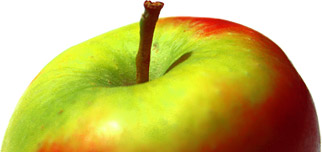Owner's comments
Ribston Pippin (Glory of York; Travers' Pippin) (taken from: http://chestofbooks.com/gardening-horticulture/Robert-Hogg/The-Fruit-Manual-Great-Britain/Apples-Part-156.html#ribston_pippin)
Fruit, medium sized; roundish, and irregular in its outline, caused by several obtuse and unequal angles on its sides. Skin, greenish yellow, changing as it ripens to dull yellow, and marked with broken streaks of pale red on the shaded side, but dull red changing to clear faint crimson, marked with streaks of deeper crimson, on the side next the sun, and generally russety over the base. Eye, small and open or closed, set in an irregular basin, which is generally netted with russet. Stamens, median or basal; tube, deep conical or funnel-shaped. Stalk, half an inch long, slender, and generally inserted its whole length in a round cavity, which is surrounded with russet. Flesh, yellow, firm, crisp, rich, and sugary, charged with a powerful aromatic flavour. Cells, obovate; axile, slit.
An apple so well known as to require neither description nor encomium. It is in greatest perfection during November and December, but with good management will keep till March.
The tree is in general hardy, a vigorous grower, and a good bearer, provided it is grown in a dry soil; but if otherwise it is almost sure to canker. In all the southern and middle counties of England it succeeds well as an open standard; but in the north, and in Scotland, it requires the protection of a wall to bring it to perfection. Nicol calls it "a universal apple for these kingdoms; it will thrive at John O'Groat's, while it deserves a place at Exeter or at Cork."
The Ribston Pippin did not become generally known till the end of the last century, and it is not mentioned in any of the editions of Miller's Dictionary, or by any other author of that period; neither was it grown in the Brompton Park Nursery in 1770. In 1785 I rind it was in that collection, when it was grown to the extent of a quarter of a row, or about twenty-five plants; and as this supply seems to have sufficed for three years' demand, its merits must have been but little known. In 1788 it extended to one row, or about one hundred plants, and three years later to two rows; from 1791 it increased one row annually, till 1794, when it reached five rows. From these facts we may pretty well learn the rise and progress of its popularity. In 1847, in the same nursery, it was cultivated to the extent of about twenty-five rows, or 2,500 plants annually.
The original tree was first discovered growing in the garden at Ribston Hall, near Knaresborough, but how, when, or by what means it came there, has not been satisfactorily ascertained. One account states that about the year 1688 some apple pips were brought from Rouen and sown at Ribston Hall; the trees produced from them were planted in the park, and one turned out to be the variety in question. The original tree stood till 1810, when it was blown down by a violent gale of wind. It was afterwards supported by stakes in a horizontal position, and continued to produce fruit till it lingered and died in 1835. Since then, a young shoot has been produced about four inches below the surface of the ground, which, with proper care, may become a tree, and thereby preserve the original of this favourite old dessert apple. The gardener at Ribston Hall, by whom this apple was raised, was the father of Lowe, who during the last century was the fruit-tree nurseryman at Hampton Wick.
